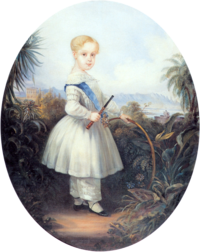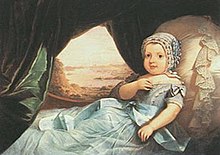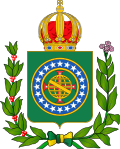Afonso, Prince Imperial of Brazil
| Afonso | |||||
|---|---|---|---|---|---|
| Prince Imperial of Brazil | |||||
 Afonso at age 2 wearing the blue band of the Order of the Southern Cross, 1846 | |||||
| Born | 23 February 1845 Palace of São Cristóvão, Rio de Janeiro, Empire of Brazil | ||||
| Died | 11 June 1847 (2 years, 108 days) Palace of São Cristóvão, Rio de Janeiro, Empire of Brazil | ||||
| Burial | Convento de Santo Antônio (Convent of Saint Anthony), Rio de Janeiro | ||||
| |||||
| House | Braganza | ||||
| Father | Pedro II of Brazil | ||||
| Mother | Teresa Cristina of the Two Sicilies | ||||
| Religion | Roman Catholicism | ||||
Dom Afonso (23 February 1845 – 11 June 1847) was the Prince Imperial and heir apparent to the throne of the Empire of Brazil. Born in Rio de Janeiro, he was the eldest child of Emperor Dom Pedro II and Dona Teresa Cristina of the Two Sicilies, and thus a member of the Brazilian branch of the House of Braganza.
Afonso died from epilepsy at the age of two, devastating the emperor. The following year, Pedro and Teresa Cristina had another son, Pedro Afonso, but he too died in infancy. After the loss of his second son, doubts grew in Pedro II's mind that the imperial system could be viable. He still had an heir in his daughter Isabel, but he was unconvinced that a female would prove to be a suitable successor. He showed less concern about the effects his policies had on the monarchy, provided his daughter Isabel with no training for her role as potential empress, and failed to cultivate her acceptance within the country's political class. Pedro II's lack of interest in protecting the imperial system ultimately led to its downfall.
Birth[edit]

Afonso was born at 13:35 on 23 February 1845 in the Palace of São Cristóvão, in Rio de Janeiro, Brazil.[1][2] He was named after his ancestor Afonso, Duke of Braganza, son of King João I of Portugal and founder of the House of Braganza (Portuguese: Bragança).[3] His full name was Afonso Pedro de Alcântara Cristiano Leopoldo Filipe Eugênio Miguel Gabriel Rafael Gonzaga.[1] Through his father, Emperor Pedro II, he was a member of the Brazilian branch of the House of Braganza (Portuguese: Bragança) and was referred to using the honorific "Dom" (Lord) from birth.[4] Afonso was the grandson of Emperor Pedro I of Brazil and nephew of Queen Maria II of Portugal.[5] Through his mother, Teresa Cristina, he was a grandson of Francis I and nephew to Ferdinand II, who ruled as kings of the Two Sicilies in turn.[6]
The U.S. minister in Brazil reported that his birth was heralded "by rockets and artillery, and was followed by a grand fête day at court... and by illuminations and displays of various sorts and public rejoicings".[7] As was customary within the House of Braganza, Afonso's birth was a formal event attended by the imperial court.[8] Pedro II immediately presented the newborn baby to the throng gathered in the palace, announcing "Gentlemen, it is a prince whom God ..."—here he was overcome with emotion and was unable to continue.[9][10] The birth of a much needed male heir—thus regarded by contemporaries—was met with joy throughout the empire.[11] Luís Alves de Lima e Silva (then Baron and later Duke of Caxias) wrote to his father: "No one was happier than I with the news [of the prince's birth]".[12]
Life and impact[edit]
The birth of an heir produced changes in Pedro II's character. Previously isolated and shy, he became more outgoing and confident as monarch.[13] His strained relationship with his wife, the product of a disappointing arranged marriage, also improved, and with children came shared domestic interests that developed into an affectionate friendship.[14]

Afonso was healthy, and as the eldest son of Pedro II, was heir to the throne and styled "Prince Imperial".[9][10] The young prince resembled his father, particularly in his face, hair and eyes.[15] Because of his gender and position as heir apparent, he became the center of attention, particularly for Pedro II.[16] A letter written by Pedro II to his elder sister Maria II a few months after the birth of his second child—a daughter named Isabel—displayed his happiness: "No news here save the good state of health of myself, of the empress, and of the little ones, who are becoming increasingly cute, principally little Afonso, who is already walking and who says many words, still half incomprehensible, the which increases their charm."[17]
Death[edit]
On 11 June 1847, the young prince was playing in the library of the palace when he experienced a series of strong convulsions and died, not quite two and a half years old.[18][19] His death revealed that Afonso had epilepsy, as did his father.[20] The grief of Pedro II and his wife was enormous. It was feared that the shock might affect Teresa Cristina's health, as she was pregnant at the time with her third child. She later gave birth without complications on 13 July to a girl, who was christened Leopoldina.[16] The devastated emperor wrote a letter to his stepmother, the Empress Amélia, dated 11 July 1847, telling her of Afonso's death: "With the most piercing grief I tell you that my little Afonso, your godson, unfortunately died of convulsions, which he suffered during five hours on the 4th of last month;[A] and a few days ago little Isabel was put at risk by a strong attack of convulsions that greatly frightened me."[16]
A grand state funeral—not seen since the death of Pedro II's sister Paula in 1833—was held for the Prince Imperial at 7 p.m. three days after his death.[18] He was buried in the Convento da Ajuda (Convent of Aid) in Rio de Janeiro.[19] When the convent was demolished in 1911 his remains were moved to the mausoleum of the Convento de Santo Antônio (Convent of Saint Anthony) in Rio de Janeiro, where other members of the Brazilian House of Braganza (including his younger brother Pedro, his uncle João and his aunt Paula) are also located.[18]
Legacy[edit]

The prince's early death (and the later demise of his younger brother) had an enormous impact on Pedro II: on a personal level, on his future conduct as monarch, and on the empire. In his eyes, the deaths of his only sons seemed to presage the end of the imperial system. Although the emperor still had a legal successor in his daughter Isabel, in the male-dominated society of the time he had little confidence that a woman could rule Brazil. He was fond and respectful of the women in his life, but he did not consider it feasible that Isabel could survive as monarch. He did nothing to prepare Isabel for the responsibilities of ascending the throne, nor did he attempt to encourage acceptance of a female ruler among the political class.[21]

Pedro II began his rule as a figurehead who held together a realm on the verge of disintegration. He quickly matured and successfully navigated the empire through repeated and serious crises. By the time of Afonso's death, the nation was entering an unprecedented era of prosperity, development and tranquility. Even as the emperor's political successes and policies began to bear fruit, the lack of a male heir caused him to lose motivation to promote the imperial office as a position to be carried on by his descendants. The emperor turned away from personal and family ties, and focused on upholding the constitution while directing Brazil toward policies that furthered modernization and social advancement. The future of the monarchy as an institution no longer mattered to him, and in 1889, he was deposed in a coup, marking the end of the Empire of Brazil.[22]
Titles, styles and honors[edit]
| Styles of Afonso, Prince Imperial | |
|---|---|
 | |
| Reference style | His Imperial Highness |
| Spoken style | Your Imperial Highness |
Titles and styles[edit]
- 23 February 1845 – 11 June 1847: His Imperial Highness The Prince Imperial
The prince's full style and title was "His Imperial Highness Dom Afonso, Prince Imperial of Brazil".[23]
Appointments[edit]
- Honorary President of the Brazilian Historic and Geographic Institute.[24]
Honors[edit]
Prince Afonso was a recipient of the following Brazilian Orders:
- Major Commander of the Order of Christ[25]
- Major Commander of the Order of Saint Benedict of Aviz[25]
- Major Commander of the Order of Saint James of the Sword[25]
- Grand Cross of the Order of Pedro I[26]
- Grand Cross and Grand Major Dignitary of the Order of the Rose[26]
Ancestry[edit]
| Ancestors of Afonso, Prince Imperial of Brazil[27] | |||||||||||||||||||||||||||||||||||||||||||||||||||||||||||||||||||||||||||||||||||||||||||||||||||||||||||||||||||||||||||||||||||||||||||||||||||||||||||||||||||||||||||||||||||||||||||||||||||||||||||||||||||||||||||||||||||||||||||||||||||||||||||||||||||||||||||||||||||||||||
|---|---|---|---|---|---|---|---|---|---|---|---|---|---|---|---|---|---|---|---|---|---|---|---|---|---|---|---|---|---|---|---|---|---|---|---|---|---|---|---|---|---|---|---|---|---|---|---|---|---|---|---|---|---|---|---|---|---|---|---|---|---|---|---|---|---|---|---|---|---|---|---|---|---|---|---|---|---|---|---|---|---|---|---|---|---|---|---|---|---|---|---|---|---|---|---|---|---|---|---|---|---|---|---|---|---|---|---|---|---|---|---|---|---|---|---|---|---|---|---|---|---|---|---|---|---|---|---|---|---|---|---|---|---|---|---|---|---|---|---|---|---|---|---|---|---|---|---|---|---|---|---|---|---|---|---|---|---|---|---|---|---|---|---|---|---|---|---|---|---|---|---|---|---|---|---|---|---|---|---|---|---|---|---|---|---|---|---|---|---|---|---|---|---|---|---|---|---|---|---|---|---|---|---|---|---|---|---|---|---|---|---|---|---|---|---|---|---|---|---|---|---|---|---|---|---|---|---|---|---|---|---|---|---|---|---|---|---|---|---|---|---|---|---|---|---|---|---|---|---|---|---|---|---|---|---|---|---|---|---|---|---|---|---|---|---|---|---|---|---|---|---|---|---|---|---|---|---|---|---|---|---|
| |||||||||||||||||||||||||||||||||||||||||||||||||||||||||||||||||||||||||||||||||||||||||||||||||||||||||||||||||||||||||||||||||||||||||||||||||||||||||||||||||||||||||||||||||||||||||||||||||||||||||||||||||||||||||||||||||||||||||||||||||||||||||||||||||||||||||||||||||||||||||
Endnotes[edit]
- ^ Pedro II was mistaken about the date of his son's death. It did in fact occur on 11 June (Barman 2002, p. 252).
Footnotes[edit]
- ^ a b Laemmert 1847, p. 35.
- ^ Schiavo 1953, p. 144.
- ^ Schiavo 1953, p. 145.
- ^ Barman 1999, p. 424.
- ^ Schwarcz 1998, p. 47.
- ^ Calmon 1975, p. 210.
- ^ Kraay 2013, p. 129.
- ^ Barman 1999, p. 110.
- ^ a b Calmon 1975, p. 274.
- ^ a b Lira 1977, Vol 1, p. 139.
- ^ Calmon 1975, pp. 274–276.
- ^ Calmon 1975, p. 276.
- ^ Barman 1999, pp. 109, 111.
- ^ Barman 1999, p. 126.
- ^ Diener & Costa 2002, p. 79.
- ^ a b c Barman 2002, p. 24.
- ^ Barman 2002, pp. 23–24.
- ^ a b c Calmon 1975, p. 317.
- ^ a b Schiavo 1953, p. 181.
- ^ Barman 1999, p. 48.
- ^ Barman 1999, pp. 129–130.
- ^ Barman 1999, p. 130.
- ^ Rodrigues 1863, p. 95.
- ^ Santo Ângelo 1848, p. 5.
- ^ a b c Laemmert 1849, p. 26.
- ^ a b Laemmert 1849, p. 24.
- ^ Barman 1999, p. 8.
References[edit]
- Barman, Roderick J. (1999). Citizen Emperor: Pedro II and the Making of Brazil, 1825–1891. Stanford, California: Stanford University Press. ISBN 978-0-8047-3510-0.
- Barman, Roderick J. (2002). Princess Isabel of Brazil: gender and power in the nineteenth century. Wilmington, Delaware: Scholarly Resources. ISBN 978-0-8420-2846-2.
- Calmon, Pedro (1975). História de D. Pedro II (in Portuguese). Vol. 5. Rio de Janeiro: J. Olympio.
- Diener, Pablo; Costa, Maria de Fátima (2002). Rugendas e o Brasil (in Portuguese). São Paulo: Capivara. ISBN 978-85-89063-08-1.
- Kraay, Hendrik (2013). Days of National Festivity in Rio de Janeiro, Brazil, 1823–1889. Stanford, CA: Stanford University Press. ISBN 978-0-8047-8610-2.
- Lira, Heitor (1977). História de Dom Pedro II (1825–1891): Ascenção (1825–1870) (in Portuguese). Vol. 1. Belo Horizonte: Itatiaia.
- Laemmert, Eduardo (1847). Almanak Administrativo, Mercantil e Industrial (Almanaque Laemmert) (in Portuguese). Rio de Janeiro: Eduardo e Henrique Laemmert & C.
- Laemmert, Eduardo (1849). Almanak Administrativo, Mercantil e Industrial (Almanaque Laemmert) (in Portuguese). Rio de Janeiro: Eduardo e Henrique Laemmert & C.
- Rodrigues, José Carlos (1863). Constituição política do Império do Brasil (in Portuguese). Rio de Janeiro: Typographia Universal de Laemmert.
- Santo Ângelo, Manuel de Araújo Porto Alegre, Baron of (1848). "Oblação do Instituto Historico e Geographico Brazileiro á memoria de seu presidente honorario o senhor Dom Affonso, augusto primogenito de SS. MM. II". Revista do Instituto Histórico e Geográfico Brasileiro (in Portuguese). XI. Rio de Janeiro: Imprensa Nacional: 5–7.
{{cite journal}}: CS1 maint: multiple names: authors list (link) - Schiavo, José (1953). "A família Imperial do Brasil". Anuário do Museu Imperial (in Portuguese). XIV. Rio de Janeiro: Ministério da Educação e Saúde: 111–247.
- Schwarcz, Lilia Moritz (1998). As barbas do Imperador: D. Pedro II, um monarca nos trópicos (in Portuguese) (2 ed.). São Paulo: Companhia das Letras. ISBN 978-85-7164-837-1.
External links[edit]
![]() Media related to Afonso, Prince Imperial of Brazil at Wikimedia Commons
Media related to Afonso, Prince Imperial of Brazil at Wikimedia Commons
- 1845 births
- 1847 deaths
- Nobility from Rio de Janeiro (city)
- Brazilian people of Austrian descent
- Brazilian people of Italian descent
- Brazilian people of Portuguese descent
- Neurological disease deaths in Rio de Janeiro (state)
- Princes Imperial of Brazil
- Heirs apparent who never acceded
- House of Braganza
- Deaths from epilepsy
- Royalty and nobility with epilepsy
- Sons of emperors
- Royal reburials
- Royalty who died as children



